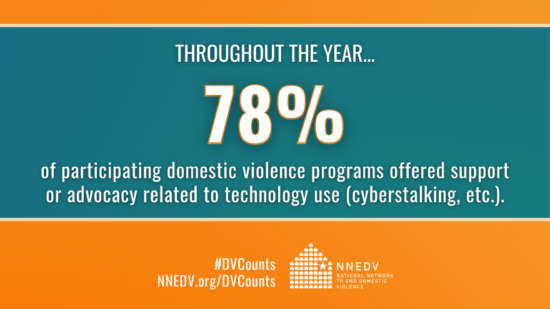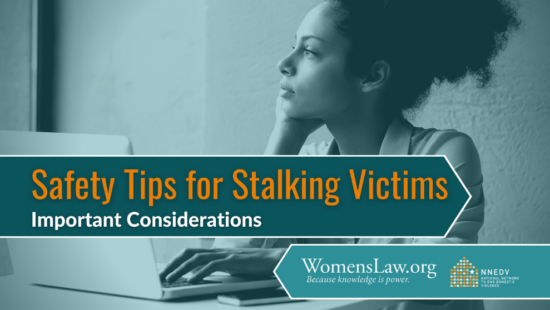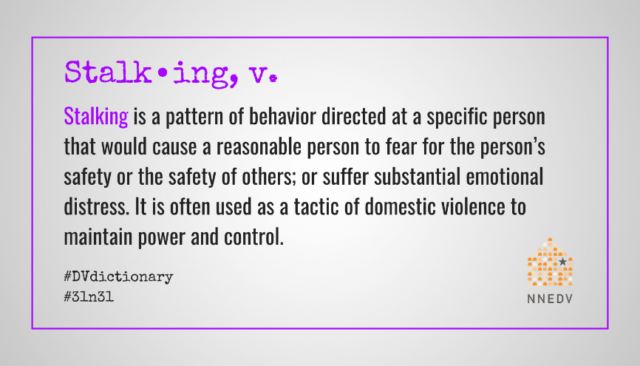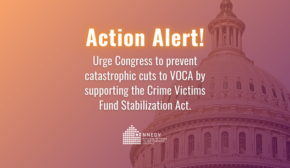The Intersections of Stalking and Domestic Violence
January 11, 2023
January marks the nineteenth annual National Stalking Awareness Month (NSAM). As defined by the Stalking Prevention, Awareness, and Resource Center, stalking is “a pattern of behavior directed at a specific person that would cause a reasonable person to fear for the person’s safety or the safety of others; or suffer substantial emotional distress.” Stalking can be a scary, even dangerous, violation of privacy impacting millions of people each year. Throughout the month, organizations and advocates share information and resources to help stalking victims and their loved ones.
Here at the National Network to End Domestic Violence (NNEDV), we recognize abusers often choose to stalk partners as a means to harm them, even after the relationship itself may have ended. Domestic violence is all about one person gaining and maintaining power and control over another person, and stalking can be one way abusers choose to accomplish this. Some common examples of stalking behaviors used by abusers include:
- Persistent, unwanted contact toward a victim through phone calls, texts, or social media;
- Sending a victim unwelcome gifts or items;
- Showing up repeatedly at a victim’s home, school, or workplace;
- Using technology to monitor a victim; and
- Threatening or harming a victim or their loved ones, pets, or property.
Research from the National Intimate Partner and Sexual Violence Survey (NISVS) shows that nearly 1 in 3 women and about 1 in 6 men in the United States reported being stalked at some point during their lives, and that 43.4% of female victims and 32.4% of male victims were stalked by a current or former intimate partner. While being stalked by anyone can be terrifying, current or former partners often weaponize their familiarity with a victim’s life in order to make their stalking behaviors more invasive—and more deadly. Additional research shows that stalking increases the risk of intimate partner homicide by three times, and survivors need support and resources to respond to these dangerous behaviors before they escalate.
Stalking and Technology
As our world becomes increasingly more digital, we know many survivors use technology strategically to increase their privacy and safety, connect with friends and family, access domestic violence resources and local services, and connect with the world around them. For survivors with disabilities, technology can help connect them with communication, education, work, and other resources that would otherwise be inaccessible.
At the same time, we know abusers also choose to misuse technology in order to stalk partners, often without their knowledge or consent. This is often called “cyberstalking” and can include the behaviors listed above and others, like using GPS technology to monitor a victim’s whereabouts, installing hidden software on a victim’s phone to gain access to accounts and passwords, or hacking into smart devices in a victim’s home. These and other behaviors may be difficult to notice or prove, making it hard for victims to identify what’s happening or be believed if they reach out for help.

NNEDV’s 16th Annual Domestic Violence Counts Report found that, throughout the year, more than 78% of participating domestic violence programs nationwide offer support or advocacy related to technology use, including cyberstalking. Advocates at these programs work hard to help survivors identify and respond to technology-facilitated abuse, being mindful that the technology itself may evolve, but the underlying abusive behaviors are often the same. NNEDV’s Safety Net team offers a number of helpful resources to guide this process, including Technology Safety Plan: A Guide for Survivors and Advocates and Documentation Tips for Survivors of Technology Abuse & Stalking. Survivors know their situations best, and our team is proud to help survivors and their advocates navigate what may (and may not) be helpful.
Legal Information for Stalking Victims
While individual stalking behaviors (like leaving unwelcome gifts) may not always feel illegal, when someone commits these actions over and over as part of a pattern to make a victim feel afraid, it may be considered stalking under certain legal definitions. This means survivors have a number of legal options to consider, if going to court feels safe and helpful in their situation.
In many states, for example, survivors can file for a restraining order against anyone who has stalked or harassed them, whether or not that person happens to be a current or former partner. For many survivors, having a restraining order can be a helpful tool for reducing (or even eliminating) the stalking behaviors altogether. Most states also include stalking as a reason for survivors to get a domestic violence restraining order, if the stalking behaviors have occurred as part of an abuser’s larger patterns of violence.

Generally, for survivors considering any kind of legal process related to stalking, it can be helpful to document evidence like phone calls, messages, voicemails, and emails, as long as this can be done safely. The Safety Net team’s Documentation Tips for Survivors of Technology Abuse & Stalking above can be a helpful place to start, and so can our DocuSAFE app—a free app that helps survivors collect, store, and share evidence of abuse. NNEDV’s WomensLaw team has additional information about Stalking/Cyberstalking and Safety Tips for Stalking Victims, including legal information and resources.
Additional Resources
All victims and survivors deserve to be safe and have access to information, resources, and support as they navigate their experiences. For victims and survivors who have been stalked by an intimate partner, there can be additional layers and considerations during the process of getting—and staying—safe. Trained advocates can help, and we encourage anyone to reach out to the below resources if it’s safe to do so:
- NNEDV’s WomensLaw.org and the WomensLaw Email Hotline, which provide state-specific, plain-language legal information and free, individualized, and confidential and support in both English and Spanish for survivors, their advocates, and their loved ones.
- The National Domestic Violence Hotline, which provides 24/7 free, confidential, and compassionate support, crisis intervention information, education, and referral services in over 200 languages via phone, chat, and text.
- VictimConnect, a weekday phone, chat, and text-based referral helpline operated by the National Center for Victims of Crime. Services are available for all victims of crime in the United States and its territories. Visitors to the hotline receive strength-based and trauma-informed services and referrals in over 200 languages.
Thank you for joining us to create a world where survivors of stalking—and all survivors—can be safe. Follow us on Facebook, Instagram, and Twitter this month as we share additional National Stalking Awareness Month resources and information.
For peace and safety,


Deborah J. Vagins
NNEDV President and CEO





